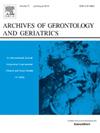Osteosarcopenia and frailty risk in community-dwelling older adults: A follow-up of the I-Lan Longitudinal Aging Study
IF 3.8
3区 医学
Q2 GERIATRICS & GERONTOLOGY
引用次数: 0
Abstract
Background
Osteosarcopenia is suggested to be on the causal pathway to frailty; however, data on this topic is scarce, and it is unclear if osteosarcopenia is associated with frailty risk.
Objectives
To investigate if osteosarcopenia is associated with frailty risk in community-dwelling older adults.
Design
Retrospective analysis of a prospective cohort study.
Setting
I–Lan Longitudinal Aging Study (ILAS).
Participants
1779 older adults (≥50 years) at baseline, and 998 participants at follow-up.
Measurements
Frailty was defined based on the Fried criteria. Osteosarcopenia was defined by the coexistence of osteopenia or osteoporosis (WHO definition) and sarcopenia (Asian Working Group definition). Multinomial logistic regression models were employed to examine the association of osteosarcopenia (at baseline) with frailty risk (at eight years), adjusted for demographic and clinical factors.
Results
Out of 1779 adults (mean age 63.9 ± 9.2 SD, women 53.1 %), 998 (mean age 67.1 ± 7.6 SD, women 52.6 %) completed a follow-up at eight years. At baseline, osteosarcopenia was more prevalent in the frail group (27.5 %) compared to the pre-frail (10.8 %) and non-frail groups (0 %). However, neither osteosarcopenia (Odds Ratio [OR] 2.67, 95 %CI 0.85–8.40, p = 0.094) nor its components (sarcopenia (OR 3.13, 95 %CI 0.64–15.21, p = 0.158); osteopenia (OR 1.33, 95 %CI 0.70–2.53, p = 0.386); osteoporosis (OR 1.71, 95 %CI 0.64–4.59, p = 0.287)) were associated with frailty risk at eight years.
Conclusion
Neither osteosarcopenia nor its components were associated with frailty risk. However, a greater number of older adults with osteosarcopenia and extended follow-up are needed to re-evaluate whether osteosarcopenia is associated with frailty risk.
社区老年人骨骼肌减少症和衰弱风险:I-Lan纵向衰老研究的随访
背景:骨质减少症被认为是导致身体虚弱的原因之一;然而,关于这一主题的数据很少,也不清楚骨质减少症是否与虚弱风险相关。目的探讨社区居住老年人骨骼肌减少症是否与衰弱风险相关。设计前瞻性队列研究的回顾性分析。i - lan纵向衰老研究(ILAS)。参与者:基线时1779名老年人(≥50岁),随访时998名参与者。根据Fried标准定义脆弱性。骨量减少症的定义是骨量减少或骨质疏松症(WHO定义)和骨量减少症(亚洲工作组定义)共存。采用多项logistic回归模型检验骨骼肌减少症(基线)与衰弱风险(8年)的关系,并根据人口统计学和临床因素进行调整。结果1779名成人(平均年龄63.9±9.2 SD,女性53.1%),998名(平均年龄67.1±7.6 SD,女性52.6%)完成了8年的随访。基线时,骨骼肌减少症在虚弱组(27.5%)比虚弱前组(10.8%)和非虚弱组(0%)更为普遍。然而,无论是骨骼肌减少症(比值比[OR] 2.67, 95% CI 0.85-8.40, p = 0.094)还是其组成部分(骨骼肌减少症(比值比[OR] 3.13, 95% CI 0.64-15.21, p = 0.158);骨质减少(OR 1.33, 95% CI 0.70-2.53, p = 0.386);骨质疏松症(OR 1.71, 95% CI 0.64-4.59, p = 0.287)与8年时的衰弱风险相关。结论骨骼肌减少症及其组成与衰弱风险均无相关性。然而,需要更多的老年骨骼肌减少症患者和长期随访来重新评估骨骼肌减少症是否与虚弱风险相关。
本文章由计算机程序翻译,如有差异,请以英文原文为准。
求助全文
约1分钟内获得全文
求助全文
来源期刊
CiteScore
7.30
自引率
5.00%
发文量
198
审稿时长
16 days
期刊介绍:
Archives of Gerontology and Geriatrics provides a medium for the publication of papers from the fields of experimental gerontology and clinical and social geriatrics. The principal aim of the journal is to facilitate the exchange of information between specialists in these three fields of gerontological research. Experimental papers dealing with the basic mechanisms of aging at molecular, cellular, tissue or organ levels will be published.
Clinical papers will be accepted if they provide sufficiently new information or are of fundamental importance for the knowledge of human aging. Purely descriptive clinical papers will be accepted only if the results permit further interpretation. Papers dealing with anti-aging pharmacological preparations in humans are welcome. Papers on the social aspects of geriatrics will be accepted if they are of general interest regarding the epidemiology of aging and the efficiency and working methods of the social organizations for the health care of the elderly.

 求助内容:
求助内容: 应助结果提醒方式:
应助结果提醒方式:


